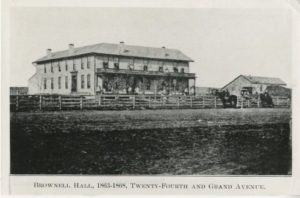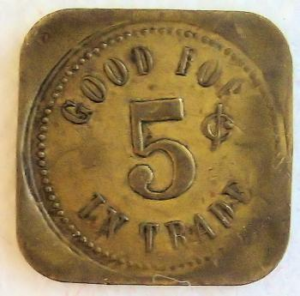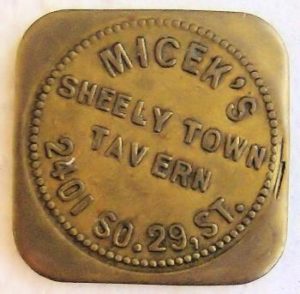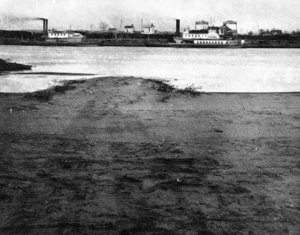When Omaha (“Omaha City”, as it was then known) was officially incorporated in 1854, it was much, much smaller than its current boundaries. Because the city was being built from hardly anything, the first platting was very precise, dividing the land into 320 blocks exactly 264 feet square.[1] Most streets were 100 feet wide (the only exceptions being Capitol Ave and 21st St., which were 120 feet wide). An inaugural census mandated by the Nebraska Territorial Legislature, completed in November 1854, reported a total of 645 inhabitants within Douglas County. There was no distinction between residents of incorporated or non-incorporated areas, but an estimation has placed the original population of Omaha at approximately 200.[2]
By 1855, another swath of land to the north and west of Omaha City was purchased by the Omaha Land Company, a private company owned by several businessmen who had been involved in the founding of Omaha City. The land was purchased with scrip, the only currency available in Omaha at the time, thus leading to its becoming known as Scriptown. This area encompassed present-day Cuming St. to Fort St., from 16th to 24th, and construction and development progressed quickly. It was incorporated into Omaha in 1877, as the city’s first annexation.

An example of scrip issued by the Omaha City Bank and worth $1. Image courtesy of https://currency.ha.com/itm/obsoletes-by-state/nebraska/omaha-nebraska-territory-omaha-city-bank-and-land-co-1-18-/a/141746-82125.s
Another town, Saratoga Springs, had been founded the year after Scriptown, in 1856. The official boundaries of this town are listed as Locust St. to Fort St., from Carter Lake to North 36th St., which does raise a question, as there seems to have been some overlap between this space and the northern boundary of Scriptown. In any case, Saratoga Springs was located just three miles north of downtown Omaha, while also being in proximity to Sulphur Spring, whose popularity for health remedies inspired the construction of the Saratoga Springs Hotel. At the time of the town’s founding, it was near the Saratoga Bend on the Missouri River, which saw many steamboat landings. In 1877, however, the Missouri River changed its course almost overnight, creating the body of water that is Carter Lake and cutting the town off from the river.[3] After a few years of stagnation, the city of Omaha annexed Saratoga Springs in 1887.

Saratoga Springs Hotel, later known as Brownell Hall. Image courtesy of Douglas County Historical Society.
Omaha City grew substantially in 1887, as it expanded to the south as well with the addition of Sheelytown. This was a “town” put up by the Sheely Brothers Packing Houses, owned by Joseph Sheely, for the purpose of housing the many newly-arrived immigrants who worked for the company. The plant was located just southeast of Hanscom Park, and Sheelytown was just south of that, between present-day Edward Creighton Boulevard and Vinton Street, and South 24th and 35th. Its original occupants in the 1860-70s were largely Irish. Soon, both Polish and Czech immigrants began arriving in the area in large numbers, as well.

Token for Micek’s Sheelytown Tavern. Image courtesy of muddobber16 at http://tokencatalog.com/token_record_forms.php?action=DisplayTokenRecord&td_id=342881&inventory_id=321120&attribution_id=350421
Next time, we’ll address the next chronological annexations, which occurred in 1915.
[1] https://en.wikipedia.org/wiki/Timeline_of_Omaha,_Nebraska_history
[2] Hoag, Bertie Bennett. “The Early History of Omaha from 1853 to 1873. Master’s Thesis, University of Nebraska at Omaha. p. 18. 1939.
[3] Becker, H.W. The Forming of Carter Lake. July 1977. Accessed via the Wayback Machine: https://web.archive.org/web/20070923053311/http://www.cityofcarterlake.com/history_forming.html


